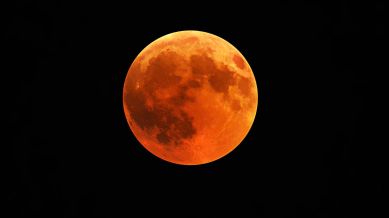Blood moon total lunar eclipse: How to watch it live on September 7-8
From Mumbai to London, millions will be able to see the Moon turn red during a rare celestial show.

Millions of people across Asia and Europe are expected to witness a total lunar eclipse that will turn the moon blood red. The celestial event is expected to happen overnight on September 7 and 8. Reportedly, skywatchers across Asia, Western Australia, and Europe will be able to witness the red ‘blood moon’.
At 5:11 pm EDT (around 2:41 am IST) on September 7, the lunar eclipse will attain its maximum phase, meaning the moon will be fully engulfed in Earth’s dark umbral shadow. When the moon is entirely immersed in the umbral shadow, it is known as totality, and this time the phase is expected to last 82 minutes.
The totality viewing times vary across different time zones, and the lunar eclipse will be visible across multiple regions. Reportedly, 77 per cent of the world’s population will be able to see the entire total phase of the eclipse.
In London (BST), the Moon rises already in eclipse between 7:30 and 7:52 pm, while in Paris (CEST) and Cape Town (SAST), it runs from 7:30 to 8:52 pm; Istanbul, Cairo, and Nairobi (EEST/EAT) see it from 8:30 to 9:52 pm, and Tehran (IRST) from 9:00 to 10:22 pm.
Meanwhile, in Mumbai (IST), it spans 11:00 pm–12:22 am. Bangkok (ICT) observes 12:30–1:52 am, Beijing (CST), Hong Kong (HKT), and Perth (AWST) from 1:30–2:52 am, Tokyo (JST) 2:30–3:52 am, and Sydney (AEST) 3:30–4:52 am.
What happens during the total eclipse?
The moon enters the Earth’s penumbral shadow, marking the beginning of the eclipse. And, as the moon moves further into the umbra, a dark shadow is cast across the lunar surface until totality, which brings a reddish-orange hue. The colour of the moon is largely dependent on the atmospheric conditions on Earth during the eclipse.
The lunar eclipse on September 7-8 happens just 2.7 days before the moon reaches perigee – the point in the moon’s elliptical orbit where it comes closest to Earth. This makes it appear slightly bigger than its usual size. As it moves through Earth’s umbra, the darkest part of the shadow, the Moon is expected to glow in a rich and dark hue of red.
Those watching from Asia and Australia are likely to have the best experience, as the Moon will be high overhead during totality. This would make it perfect for casual viewing and photography. Meanwhile, in Europe and Africa, the eclipse will be seen at moonrise, offering a stunning horizon view.
The total lunar eclipse will be visible to the naked eye whenever it happens above the horizon. Unlike solar eclipses, lunar eclipses are safe to view; one need not use special glasses, filters, or any other equipment. Since the reddish glow of the Moon in totality is caused by Earth’s atmosphere scattering sunlight, it can be best viewed with the naked eye. While binoculars or a small telescope can enhance details, they are not necessary.